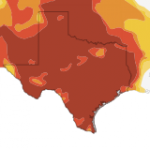Here’s a New Way to Keep Your Cattle STD-Free

Photo by DAMIEN MEYER/AFP/Getty Images
The Texas Animal Health Commission is changing the way it tests for a trichomoniasis.
They don’t prepare you for this kind of story in journalism school, but here goes:
Texas cattle have an STD problem.
This month the Texas Animal Health Commission announced new regulations on how to test for a venereal disease among cattle called Tricomoniasis. Dr. Dee Ellis, Executive Director of the Commission, and Texas State Veterinarian estimates that between two to five percent of Texas cattle are infected by the disease.
Before you spit out that hamburger, a couple of disclaimers:
1) The disease doesn’t impact humans. It’s only spread between cattle when they mate (nearly all are still bred the old-fashioned way in Texas, not through artificial insemination).
2) Texas is actually further ahead in testing for the disease than some other parts of the world. The state requires all cattle imported into the state to be tested. Canada and Mexico, for example, don’t test for the disease.
A Question of Cost
The reason the state tests for it is because Tricomoniasis causes cows to abort their calves early, costing ranchers thousands of dollars.
“Some of the herds that are infected may be having only about a 50 percent calf crop. The goal is 90 percent or above on your calf crop,” Dr. Ellis tells StateImpact Texas. A 50 percent calf crop means that only half of the heifers that mate give birth.
With calves currently selling for up to $1,000 at auction, “even losing one calf is a $1,000 bill,” he added.
In order to combat Tricomoniasis, Texas cattle raisers entered into a voluntary testing program with the Animal Health Commission, in which skin scrapings of bulls are sent to Texas A&M University labs for testing. But there was a problem there as well: the cost. Each sample cost $25 to test.
The new system, proposed last week by the commission, will allow cattle producers to “pool” groups of five samples they send into the lab, saving them money on tests.“What our rules are going to allow is for a veterinarian to take five samples, they’re gonna send it to the lab and say ‘pool it.’ And so the laboratory can take a specimen sample from each pouch and put them in one new pouch, and then run the test as one test,” says Dr. Ellis.
Under the old system, testing five samples at $25 each would cost $125. Under the new system, it will cost $30 ($25 with a $5 fee for pooling the samples), says Terry Hensley, assistant director of the lab. He said that should save ranchers $90 per five samples tested, if the tests come back negative.
“Now obviously, if they get a positive on a pooled sample, then they have to go back and run it individually. But on five negative ones you’ve paid for one test instead of five tests,” Ellis says. “It saves the producers 75 to 80 percent of the costs, so for folks with a lot of bulls, it can save them a lot of money.”
Ellis says that the Commission has conducted a study to see if the pooling practice resulted in a less accurate test, but that “we don’t think there’s enough of a difference to warrant the extra costs.”
Ellis thinks that will come as especially good news to cattle raisers as they try to rebuild their herds in the aftermath of the 2011 drought that devastated the cattle population across the state.

